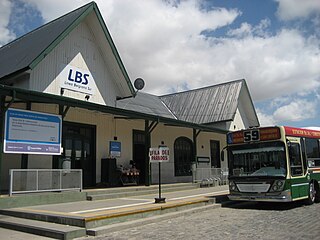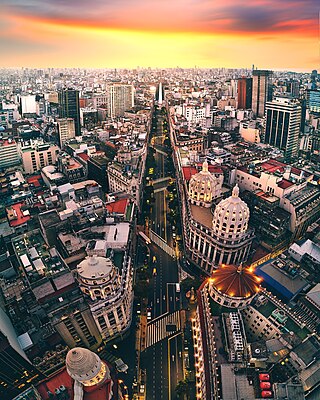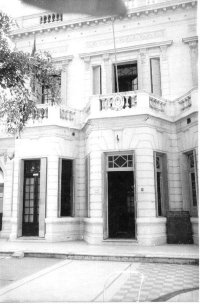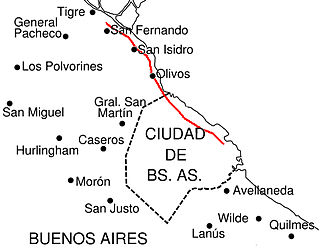

The San Isidro Cathedral is located in the city of San Isidro, in the province of Buenos Aires, Argentina. It is at 16200th Del Libertador Avenue, opposite Plaza Mitre or Plaza de San Isidro in San Isidro's historic quarter.


The San Isidro Cathedral is located in the city of San Isidro, in the province of Buenos Aires, Argentina. It is at 16200th Del Libertador Avenue, opposite Plaza Mitre or Plaza de San Isidro in San Isidro's historic quarter.
Built on the site of a 1706 chapel opened by the city's founder, Captain Domingo de Acassuso, the cathedral was designed by French architects Dunant and Paquin, and inaugurated on July 14, 1898.
Constructed in neogothic style, it stands 68 m (223 ft) tall. Its base is a Latin cross. Its walls are built from stone and bricks, and it has stained glass windows. The cathedral underwent a restoration project which was completed in 2007.
Isidore the Labourer festival is celebrated on 15 May each year.

Nearly 100 metres in front of the cathedral is the Plaza de San Isidro, and on it, is the San Isidro artisan fair since 1971. This fair has 100 stands, where people can buy leather, wood, textile, metal and ceramic products.
The "San Isidro Artisan Fair" is oldest in the Buenos Aires Province.
Two hundred metres off the cathedral is the San Isidro railway station, of the rail transport company Tren de la Costa. This station includes a trade center, cinema and restaurants among other things.

San Telmo is the oldest barrio (neighborhood) of Buenos Aires, Argentina. A well-preserved area of the Argentine metropolis, it hosts some of its oldest buildings. One of the birthplaces of tango, during the mid 20th century it was the Bohemian district with painters ateliers and jazz clubs. Cafes, tango parlors and antique shops line the cobblestone streets, which are often filled with street artists and dancers.

San Isidro is an affluent partido of Buenos Aires Province, Argentina found in the north of Greater Buenos Aires. Its capital is the city of San Isidro. It is 21 km (13 mi) from the city of Buenos Aires.

Recoleta is a barrio or neighborhood of Buenos Aires, Argentina, located in the northern part of the city, by the Río de la Plata. The area is perhaps best known to be the home of the distinguished Recoleta Cemetery. It is a traditional upper-class and conservative neighborhood with some of the priciest real estate in the city, known for Paris-style townhouses, lavish former palaces and posh boutiques.

Constitución railway station is a large railway station in Constitución, a barrio in central Buenos Aires, Argentina. The full official name of the station is Estación Plaza Constitution reflecting the fact that the station is located opposite Constitution Square, two kilometers to the south of the Obelisco landmark. The ground floor of the station has fourteen tracks and the floor below has two tracks for the Buenos Aires Underground. It serves as the South terminal for the city.

Retiro is a barrio or neighborhood in Buenos Aires, Argentina. Located in the northeast end of the city, Retiro is bordered on the south by the Puerto Madero and San Nicolás, and on the west by the Recoleta.
Beccar is a town located 17 km (11 mi) north of the Buenos Aires metropolitan area in the Buenos Aires Province, Argentina. It is part of the partido of San Isidro in Gran Buenos Aires. It is situated close to the historic town of San Isidro and it is characterized by tree lined streets and plazas, red tiled roofed style chalets, high-rise apartment buildings that line the Avenida Centenario zone and by being close to the coast of Rio de la Plata river and yacht clubs. Nearby there is a large shanty town (Villa La Cava). Beccar is served by a 10-minute walk to scenic Tren de la Costa light rail line at Punta Chica station and the commuter railway at Beccar station with easy access to Buenos Aires city centre and the weekend retreat of the Village of Tigre.

Buenos Aires is a former passenger railway station in the city of Buenos Aires, Argentina. The station was terminus of the Belgrano Sur line that runs trains along Greater Buenos Aires region.

Federico Lacroze railway station is a passenger railway station in Buenos Aires, Argentina. The station is located in the city's outlying barrio (neighbourhood) of Chacarita in a predominantly residential area. It is just a short distance north of the Cementerio de la Chacarita, the city's largest cemetery. The station is named after Federico Lacroze, a prominent 19th century Argentine railway and transport pioneer who obtained the concession for building the Buenos Aires Central Railway in 1884. When the Argentine railway network was nationalised in 1948 the station became the Buenos Aires terminus for the lines that became part of the General Urquiza Railway (FCGU).
San Isidro is a city in Greater Buenos Aires. It is located 27.9 km from the Autonomous City of Buenos Aires (CABA). It ranks as the province's most affluent neighborhood.

Tren de la Costa is a suburban 15.5 km (9.6 mi), 11-station light rail line in Greater Buenos Aires, between Maipú Avenue station in the northern suburb of Olivos and Delta station in Tigre, on the Río de la Plata. The line connects with the Mitre line at Maipú station, via a footbridge across Avenida Maipú, for direct access to Retiro terminus in central Buenos Aires.

Plaza San Martín is a park located in the Retiro neighbourhood of Buenos Aires, Argentina. Situated at the northern end of pedestrianized Florida Street, the park is bounded by Libertador Ave. (N), Maipú St. (W), Santa Fe Avenue (S), and Leandro Alem Av. (E). Its coordinates are 34°35′42″S58°22′32″W.

The General Bartolomé Mitre Railway (FCGBM), named after the former Argentine president Bartolomé Mitre, is one of the six state-owned Argentine railway lines formed after President Juan Perón's nationalisation of the railway network in 1948 and one of the largest of Argentina. The six divisions, managed by Ferrocarriles Argentinos were later broken up during the process of railway privatisation beginning in 1991 during Carlos Menem's presidency.

Avenida Roque Sáenz Peña, better known as Diagonal Norte, is an important avenue in the San Nicolás neighborhood of Buenos Aires, Argentina. It is oriented south-east/north-west, diagonally bisecting the city blocks (manzanas) which give the city centre a checkerboard plan. It is named after President Roque Sáenz Peña, who held power from 1910 to 1914 and passed the law which established universal suffrage, secret ballot and an electoral register.

Acassuso is a locality in the San Isidro "partido" of Buenos Aires Province. It is about 16 kilometres north of the city of Buenos Aires, between Olivos and San Isidro. It borders on the River Plate where an approximately 10 hectare municipal nature reserve "Refugio Natural Educativo de la Ribera Norte" exists since 1994. It is served by two commuter train services, the Tren de la Costa tourist line and the Mitre line.

The Colegio Nacional de San Isidro (CNSI) is a public high school located in San Isidro, Buenos Aires, Argentina.

Avenida Rivadavia is one of the principal thoroughfares in Buenos Aires, Argentina, extending 23 miles (37 km) from downtown Buenos Aires to the western suburb of Merlo. It is considered the third longest avenue in the world after Yonge Street (Toronto) and Western Avenue (Chicago).

Avenida del Libertador is one of the principal thoroughfares in Buenos Aires, Argentina, and in points north, extending 25 km (16 mi) from the Retiro District of Buenos Aires to the northern suburb of San Fernando.

Avenida Santa Fe is one of the principal thoroughfares in Buenos Aires, Argentina. The artery is essential to the imaginary axis of Barrio Norte in Buenos Aires, comprising the areas influenced by the route of the avenue through Retiro, Recoleta and Palermo neighborhoods, it is considered one of the main shopping and strolling areas of the city, its many boutiques range from elegant to edgy, which has led it to be dubbed the 'Avenue of Fashion'. Upscale Alto Palermo, at Avenida Coronel Díaz, is one of the city's best-known vertical malls. Avenida Santa Fe is also an attraction for its architecture, strongly reminiscent of Paris. Its name pays homage to the eponymous province in Argentina.

National Primary Route 2, formally known as Carretera Interamericana Sur, is the southern segment of the Pan-American Highway that traverses Costa Rica.